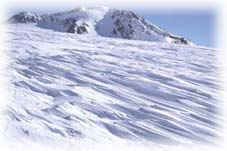|
|
|
|
The Ice Caps : a long and msyterious metamorphosis of ice When it has fallen, the snow, like everywhere else, is transformed into ice. This change operates according to a series of complicated dynamics such as the difference in pressure between the layers of ice, the thermal gradient, the packing down of the layers, sublimation (transformation of ice into vapour or vice versa), the density and compression of the ice. In summary, it could be said that as soon as the snow falls, the grains become increasingly compact ; at a certain moment, the limit of the packing down of the snow is reached, but the pressure continues. There then follows a rarefaction of the pockets of air contained in the snow that can still nevertheless remain in contact with the exterior. When the packing down of the layers of snow is over, the formation of the névé begins; the crystals change their shape and size (at the surface, they measure less than 1 millimetre; at 200 metres down, they can reach up to 6 centimetres in diameter). The névé becomes denser and the pores disappear. The air in then trapped in the form of small, occluded bubbles: it is at this moment that the ice is formed.
|


